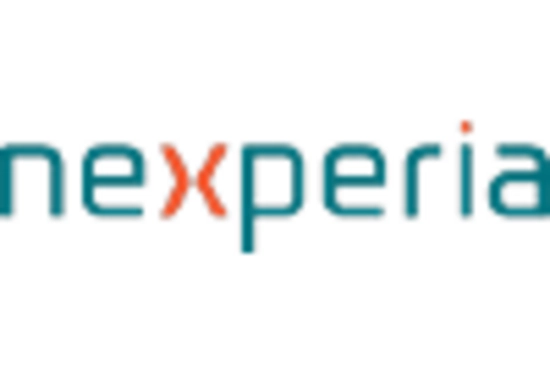Rising Demand for IoT Devices
The proliferation of Internet of Things (IoT) devices is a key driver for the Consumer Discrete Semiconductor Market. As more devices become interconnected, the need for discrete semiconductors that facilitate communication and data processing is increasing. In 2025, the IoT market is projected to surpass 1 trillion USD, highlighting the vast potential for semiconductor applications. Discrete semiconductors are essential for ensuring efficient operation and connectivity in IoT devices, ranging from smart home systems to industrial applications. This growing demand for IoT solutions is likely to stimulate innovation and investment in the semiconductor sector, thereby enhancing the Consumer Discrete Semiconductor Market. As manufacturers respond to this trend, the market is expected to witness significant growth, driven by the need for advanced semiconductor technologies.
Expansion of Automotive Electronics
The automotive sector is undergoing a transformation, with an increasing reliance on electronic components, which significantly impacts the Consumer Discrete Semiconductor Market. The integration of advanced driver-assistance systems (ADAS) and electric vehicle (EV) technologies is driving the demand for discrete semiconductors. In 2025, the automotive electronics market is expected to exceed 300 billion USD, reflecting a growing trend towards electrification and automation. Discrete semiconductors play a crucial role in managing power and ensuring efficient operation of automotive systems. As manufacturers strive to meet regulatory standards and consumer expectations for safety and efficiency, the demand for high-quality discrete semiconductors is likely to rise. This trend suggests a promising outlook for the Consumer Discrete Semiconductor Market as it aligns with the broader automotive electronics expansion.
Growth in Renewable Energy Applications
The shift towards renewable energy sources is influencing the Consumer Discrete Semiconductor Market significantly. As countries invest in solar and wind energy, the demand for efficient power conversion and management solutions is increasing. Discrete semiconductors are vital in inverters and power management systems that facilitate the integration of renewable energy into the grid. In 2025, the renewable energy market is projected to reach over 1 trillion USD, indicating a substantial opportunity for semiconductor manufacturers. The need for reliable and efficient energy solutions is likely to drive innovation in discrete semiconductor technologies. This trend not only supports the growth of the Consumer Discrete Semiconductor Market but also aligns with global sustainability goals, making it a critical driver for future developments.
Increasing Adoption of Consumer Electronics
The Consumer Discrete Semiconductor Market is experiencing a surge in demand due to the increasing adoption of consumer electronics. As households integrate more devices such as smartphones, tablets, and smart home appliances, the need for discrete semiconductors becomes more pronounced. In 2025, the market for consumer electronics is projected to reach approximately 1 trillion USD, indicating a robust growth trajectory. This growth is likely to drive the demand for discrete semiconductors, which are essential for power management and signal processing in these devices. The proliferation of high-performance electronics necessitates advanced semiconductor solutions, thereby enhancing the market's potential. Furthermore, as consumers seek more sophisticated features in their devices, manufacturers are compelled to innovate, further propelling the Consumer Discrete Semiconductor Market.
Technological Advancements in Semiconductor Manufacturing
Technological advancements in semiconductor manufacturing processes are poised to enhance the Consumer Discrete Semiconductor Market. Innovations such as advanced lithography techniques and materials science breakthroughs are enabling the production of smaller, more efficient discrete semiconductors. These advancements are crucial as they allow manufacturers to meet the increasing performance demands of modern electronic devices. In 2025, the semiconductor manufacturing market is expected to grow significantly, driven by the need for high-performance components. As manufacturers adopt cutting-edge technologies, the efficiency and reliability of discrete semiconductors are likely to improve, thereby expanding their applications across various sectors. This evolution in manufacturing processes suggests a promising future for the Consumer Discrete Semiconductor Market, as it adapts to the changing landscape of technology.














Leave a Comment